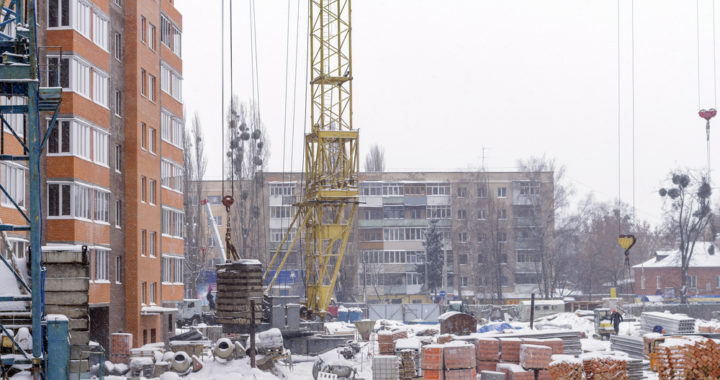
Tips For Working With Concrete In Cold Weather
The general category of “cold weather concrete” applies to a period of three days or more where specific conditions occur while concrete is exposed. Per the American Concrete Institute, here is what those different weather conditions entail:
— An average daily air temperature lower than 40°F.
— Air temperature not exceeding 50°F for over half of a 24-hour period.
When these specific conditions are present, concrete contractors need to make specific provisions to ensure that their concrete is safe both from freezing in the pouring stage and become strong enough to remove forms safely. Also, more steps need to be taken to make sure that the concrete can cure properly and ultimately become a safe and secure structure. Here are some tips that contractors can follow to handle and use cold weather concrete properly.
Photo by sakoat contributor
Understand Your Base Needs
As a baseline, in order for any new cold-weather concrete to be serviceable, it needs to meet the following conditions:
— Compressive strength of 4000 psi at a minimum.
— A 0.45 water/cementitious ratio at a maximum.
— Air entrainment levels maintenance between 5 and 7 percent.
— No exposure to any de-icers for a year.
Failing to hold to these figures causes multiple issues, and this largely happens when contractors are either trying to rush to meet a schedule or dealing with financial concerns. However, this still isn’t a step that you want to take because there are severe consequences. If freshly placed concrete ends up freezing, it can heavily impact the strength of your final product. Even in situations where the strength isn’t compromised, problems can still develop. For example, if ice crystals appear in concrete over winter, surface issues can occur during the spring. This includes flaking, pockmarks, and scaling.
Take Extra Steps During Preparation
Much of the work in dealing with cold weather concrete is done before you put the concrete in place. One key example of this is preheating either the water, the aggregate, or both. This will help ensure that your concrete keeps to the temperature levels needed to avoid freezing. This may require slightly adjusting the mixture to fit cold weather. Many companies either increase the ratio of cement in the concrete or use accelerating admixtures. Accelerating admixtures are designed as a supplement to help concrete set faster in cold weather. Examples include sodium nitrite and calcium nitrite. There are also some options like calcium chloride, which are appropriate but can’t be used in reinforced concrete.
One note here regarding accelerating admixtures is that while these help concrete set faster, they are designed to supplement best practices, not replace them. You still need to apply appropriate heating and protective measures, or the concrete will still freeze. There are also certain materials like slag cement or fly ash that is inappropriate for cold weather use.
Photo by Andy Dean Photography
Protective Options During Pouring
It’s generally a good idea for your finishing crews to budget additional time for them to be available during the pouring process. This is because, by nature, cold weather means it takes longer for concrete to set. There are also various other tools that you can use to manipulate/alleviate the ambient temperature to keep concrete from freezing and help it set faster.
Windbreaks protect the concrete and your team from cool winds that could cause evaporation and temperature drops. Six feet high will generally be enough as a baseline, but you can go taller or shorter based on wind velocity or concrete placement.
While heated enclosures are probably your best option in terms of protecting concrete in cooler weather, these are generally the most expensive options as well. You can create enclosures with wood, canvas, polyethylene, or buy prefab ones. In terms of heaters, you want to make sure you use indirect fired heaters.
Managing Curing With Cold Weather Concrete
We’ve covered in the past how important curing is to the concrete process, and this applies even more to cold weather concrete. When forms are being used, make sure they are set in place as long as possible. This will help them to retain heat and ensure that the concrete doesn’t dry out too quickly. Edges and corners are where you want to focus on the most. If you want, you can pump in live steam into your enclosures to keep the curing concrete from drying out too quickly. This is best done by making sure that it stays at 40°F at a minimum.
Another area to focus on is making sure that you avoid the concrete cooling out too rapidly. This can be handled by making sure that you lower the temperature gradually, either by manipulating the enclosure or using insulating blankets. For a larger structure, you may need to spend days or weeks slowly cooling down the structure. If you do this too quickly, cracks can occur.
Phot by Aisyaqilumaranas
Concrete is a valuable material, and you want to make sure that you are getting the most use possible out of it when it comes to your different projects. However, it’s important as well to make sure that you’re not losing some of this valuable material because of poor practices or mistakes on the part of your employees. The best way to avoid this happening is by ensuring that you are properly tracking operations, but this can be a tall order with office teams trying to track field teams.
Conclusion of Cold Weather Concrete
The best asset that concrete companies have to make sure that their teams are adhering to cold weather concrete practices is project management software like eSUB. How does project management software make a difference? We have tools to help you track your employees and your equipment to fully understand how exactly concrete is being set and used in cold weather. If there is an issue or a deviation from best practices, you can act on it accordingly.






